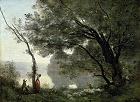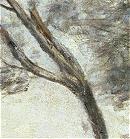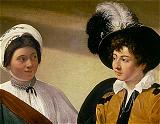
Feature Archive
December, 2001
Le Louvre: The Virtual Visit on DVD-ROM
(Software for Windows and Macintosh)
| By Joseph Phelan |
 On a trip to Paris last year, I stayed at a modest hotel filled with other North Americans. Most of them were on a five-day vacation, but being Americans they were wonderfully organized and energetic, determined to see as much of Paris as possible. As if there wasn't enough to do in Paris, they had scheduled day trips as far west as Normandy and the Loire Valley.
On a trip to Paris last year, I stayed at a modest hotel filled with other North Americans. Most of them were on a five-day vacation, but being Americans they were wonderfully organized and energetic, determined to see as much of Paris as possible. As if there wasn't enough to do in Paris, they had scheduled day trips as far west as Normandy and the Loire Valley.At breakfast on their last day I turned to my favorite topic: which museums had they been to and what things had they enjoyed? Well not only had they done the Louvre, the Musée d'Orsay and several others, but also being Americans they had all sorts of opinions about them. They loved the d'Orsay. It's like the most elegant shopping mall imaginable, a high school student from Florida announced.
About the Louvre they were respectful but after a couple of minutes one savvy New England couple (better traveled by far than I) allowed that apart from seeing the Mona Lisa they hadn't really enjoyed themselves. I bit my tongue; it would have been ludicrous to tell them that in the same gallery where thousands each day visit the La Giaconda, they could have seen three of the noblest works ever fashioned by mortal hands: Giorgione's Fête champêtre, Titian's The Entombment and Veronese's The Wedding Feast at Cana. I changed the subject, thinking the Louvre needs to reach these people...
These four paintings and 996 other works of art are now easily accessible thanks to the collaboration between Montparnasse Multimedia. which has been producing cultural CD-ROMs for almost a decade, and the Louvre Museum. The DVD-Louvre is a qualitative advance over the older CD-ROM versions. Not that there was anything wrong with the earlier versions, but with DVD the picture quality available is truly astonishing and ten times as many images can be packed onto the disc.
 The Louvre is one of the world's great encyclopedic museums containing the art and artifacts of ancient civilizations. The DVD begins with the great civilizations of Egypt and the Middle East. Thanks to Napoleon's conquests in that part of the world, the Egyptian galleries rank with those of the British Museum as the best outside of Egypt. This program offers a virtual visit to those galleries and access to over 100 ravishing items culled from the great periods of Egyptian history.
The Louvre is one of the world's great encyclopedic museums containing the art and artifacts of ancient civilizations. The DVD begins with the great civilizations of Egypt and the Middle East. Thanks to Napoleon's conquests in that part of the world, the Egyptian galleries rank with those of the British Museum as the best outside of Egypt. This program offers a virtual visit to those galleries and access to over 100 ravishing items culled from the great periods of Egyptian history.Interactive films are a major feature covering the history of the civilizations of the Mediterranean Basin from 10,000 B.C. to 1848 A.D. The films are on the level of a really interesting episode of the Discovery Channel -- brilliantly illustrated with the Louvre's holdings. There are also virtual tours of 25 of the most famous galleries, which allows you to navigate at your own pace, moving up close to the paintings and walking around the sculptures and antiquities, accompanied by a fine audio commentary. Finally there is a multimedia history of the architecture of the institution from its first use as the fortress of Philipe Auguste to the construction of Grand Louvre Pyramid designed by I.M. Pei in the early nineties.
For the vast majority of people, the Louvre stands for great painting, perhaps the greatest collection of paintings in the world. Yet it is well known that North Americans faced with their first visit to the museum often feel overwhelmed, get lost, and never really see the works, apart from the Mona Lisa. For those who love paintings and graphic arts but were unable to visit or were intimidated, this is a Louvre without the hassle.
I can tell you that there are over 345 paintings and 75 drawings from all the great periods of European art on the DVD, each of which can be devoured at your leisure accompanied by all the information you could wish to have to fully enjoy them. For instance the program provides thematic links to other works, which draw your attention to the similarities between artworks from different ages and cultures. This is multiculturalism at its best, providing the kind of comparisons that train the eye and the mind so that one can develop confidence and competence enjoying art.

 Every one of these thousand works can be seen in magnifications hitherto inaccessible to the unassisted eye. Even familiar works such as the Venus de Milo and the Mona Lisa become rich and strange under the superhuman magnification. Before you know it you are traveling in an undiscovered country seeing things most of us have only taken on faith before. For example it is often said that the Impressionists were inspired by the brushwork of the painters of the Barbizon school. Take a look at the branches of a tree in the Corot landscape [left], which under the DVD's magnification [right] blossoms into little masterpieces worthy of Monet and Renoir.
Every one of these thousand works can be seen in magnifications hitherto inaccessible to the unassisted eye. Even familiar works such as the Venus de Milo and the Mona Lisa become rich and strange under the superhuman magnification. Before you know it you are traveling in an undiscovered country seeing things most of us have only taken on faith before. For example it is often said that the Impressionists were inspired by the brushwork of the painters of the Barbizon school. Take a look at the branches of a tree in the Corot landscape [left], which under the DVD's magnification [right] blossoms into little masterpieces worthy of Monet and Renoir.The magical techniques of the old masters are revealed before your eyes. You can see how Rubens' use of color and dynamic composition influenced Delacroix and the Romantic painters. A still life in the foreground of a great Poussin becomes the inspiration for one of Cézanne's compositions. Raphael is once again seen for what he truly is, the prince of painters, the most fecund source of ideal beauty, harmony and proportion that European art has ever produced. What a resource for the serious art student or would be painter. What a treat for those who may never get to visit the Louvre!
Need I say that this program is far superior to anything available on the Internet? I speak as one of the veteran explorers of art museum websites, which have been coming online since the latter part of the 1990's. The Louvre was one of the first to go online, and the website has greatly improved over the years. But no one who has been disappointed by the paucity of works on line or the quality of the images, or the lack of solid descriptive information about the art or the artists, will need convincing that this DVD is the best interactive product this museum has yet produced.
 Websites, even the best ones, simply don't offer this much art and aren't able to provide such high definition images. The DVD Louvre includes a powerful search engine, a chronological sidebar that is always available to put things in their historical context, as well as a lexicon which can be accessed for background information. If you appreciate the high visual quality and interactive features which DVD makes possible, this Louvre is your ticket to Parnassus.
Websites, even the best ones, simply don't offer this much art and aren't able to provide such high definition images. The DVD Louvre includes a powerful search engine, a chronological sidebar that is always available to put things in their historical context, as well as a lexicon which can be accessed for background information. If you appreciate the high visual quality and interactive features which DVD makes possible, this Louvre is your ticket to Parnassus.How do you say "two thumbs up" in French?
Related Links:
- Le Louvre: The Virtual Visit on DVD-ROM: $39.99 at Amazon.com (20% off)
- More fine art software from Amazon.com
- Lots of Louvre Museum posters from AllPosters.com
- Louvre Museum Website
This article is copyright 2001 by Joseph Phelan. Please do not republish any portion of this article without written permission.
Joseph Phelan can be contacted at joe.phelan@verizon.net
Past Articles
November, 2001
Tragedy and Triumph at Arles: Van Gogh and Gauguin, by Joseph Phelan
October, 2001
Her Last Bow: Sister Wendy in America, by Joseph Phelan
September, 2001
Love, Death and Resurrection: The Paintings of Stanley Spencer, by Joseph Phelan
August, 2001
Who is Rodin's Thinker?, by Joseph Phelan
July, 2001
Celebrations North and South, by Joseph Phelan
June, 2001
Rubens and his Age, by Joseph Phelan
May, 2001
Great Reproductions of Great Paintings
April, 2001
The Passion of Christ, by Joseph Phelan
March, 2001
Edouard Manet: Public Spaces, Private Dreams, by Joseph Phelan
February, 2001
Henry Moore and the British Museum: The Great Conversation, by Joseph Phelan
December, 2000
Advent Calendar 2000, narrated by Joseph Phelan
November, 2000
Article: Notorious Portraits, Part II, by John Malyon
October, 2000
Article: Notorious Portraits, Part I, by John Malyon
Article: The Other Michelangelo, by Joseph Phelan
September, 2000
Article: The Art of Drawing, by Joseph Phelan
August, 2000
Article: Poussin and the Heroic Landscape, by Joseph Phelan
July, 2000
Article: Great Art Museums Online, by Joseph Phelan
June, 2000
Article: Venetian Painting and the Rise of Landscape, by Joseph Phelan
May, 2000
Article: Forbidden Visions: Mythology in Art, by Joseph Phelan
April, 2000
Article: Themes in Art: The Passion of Christ, by Joseph Phelan
Web site review: Christus Rex
March, 2000
Web site review: National Gallery of Art, Washington, D.C., by Joseph Phelan
Online exhibit review: Inuit Art: The World Around Me, by John Malyon
February, 2000/Poll: Who is Producing the Most Interesting Art Today? (Results)
January, 2000/Poll: Who is Producing the Most Interesting Art Today? (Part II)
December, 1999/Poll: Who is Producing the Most Interesting Art Today? (Part I)
November, 1999/The Louvre Museum
Web site review: The Louvre
October, 1999/Impressionism
Web site review: North Carolina Museum of Art
September, 1999/Optical Art
Web site review: The Butler Institute of American Art
August, 1999/Animals in Art
Web site review: National Museum of Wildlife Art
Online exhibit review: PBS: American Visions
July, 1999/Surrealism
June, 1999/Sculpture
Web site review: Carol Gerten's Fine Art
Online exhibit review: Michael Lucero: Sculpture 1976-1995
May, 1999/Women in the Arts
Web site review: National Museum of Women in the Arts
Online exhibit review: Jenny Holzer: Please Change Beliefs
April, 1999/The Golden Age of Illustration
Web site review: Fine Arts Museums Of San Francisco
Online exhibit review: Treasure Island and Robinson Crusoe online
March, 1999/Vincent van Gogh
Web site review: Van Gogh Museum, Amsterdam
Web site review: The Vincent van Gogh Information Gallery
February, 1999/Great Art
Web site review: The State Hermitage Museum, St. Petersburg, Russia
Online exhibit review: John Singleton Copley: Watson and the Shark